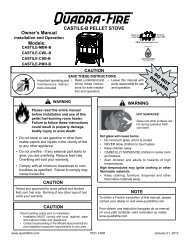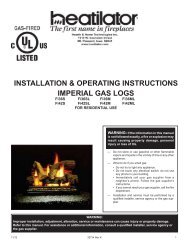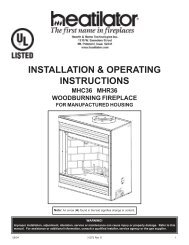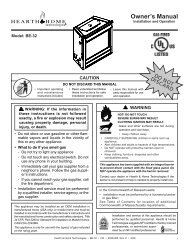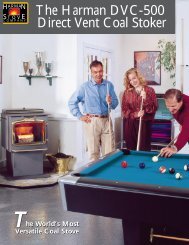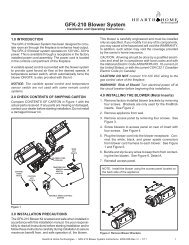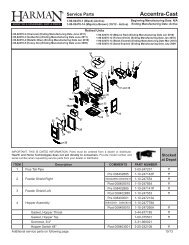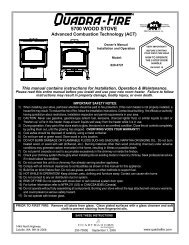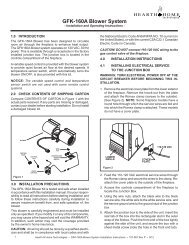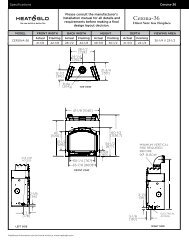Owner's Manual - Hearth & Home Technologies
Owner's Manual - Hearth & Home Technologies
Owner's Manual - Hearth & Home Technologies
Create successful ePaper yourself
Turn your PDF publications into a flip-book with our unique Google optimized e-Paper software.
3. To install the round support box/wall thimble cover ina flat ceiling, cut a 10 in. (254 mm) square hole in theceiling, centered on the hole drilled in Step 2. Framethe hole as shown in Figure 5.13.CEILING JOISTSSHINGLES OVERLAP ONTOP EDGE OF FLASHINGCAP AND STORMCOLLAR NOT SHOWNFOR CLARITYFRAMINGROUND CEILINGSUPPORT BOX/WALLTHIMBLE COVERFigure 5.14Figure 5.131-1/2 in. (38 mm)LONG WOODSCREWS4. Assemble the desired lengths of pipe and elbowsnecessary to reach from the appliance up throughthe round support box. Ensure that all pipe and elbowconnections are in their fully twist-locked position.Assemble as instructed.5. Cut a hole in the roof centered on the small drill holeplaced in the roof in Step 2. The hole should be ofsufficient size to meet the minimum requirements forclearance to combustibles, as specified. Continueto assemble lengths of pipe and elbows necessaryto reach from the ceiling support box/wall thimble upthrough the roof line. Galvanized pipe and elbows maybe utilized in the attic, as well as above the roofline.The galvanized finish is desirable above the roofline,due to its higher corrosion resistance.• If an offset is necessary in the attic to avoidobstructions, it is important to support the vent pipeevery 3 ft. (914 mm) to avoid excessive stress on theelbows, and possible separation. Wall straps areavailable for this purpose, Figure 5.12, page 16.• Whenever possible, use 45° elbows, instead of 90°elbows. The 45° elbow offers less restriction to theflow of flue gases and intake air.6. Slip the flashing over the pipe section(s) protrudingthrough the roof. Secure the base of the flashing tothe roof with roofing nails. Ensure the roofing materialoverlaps the top edge of the flashing as shown inFigure 5.14. Verify that the chimney is the requiredheight above the roof. See roof pitch table, Figure 4.3,on page 9.7. Continue to assemble pipe sections until the height ofthe vent (before adding the termination cap) meets theminimum code requirements as outlined in the currentCAN/CGA-B149 Installation Codes (in Canada), theNational Fuel Gas Code NFPA 54/ANSI Z223.1 (inUSA), or local codes. Note that for steep roof pitches,the vent height must be increased. See Roof PitchTable (Figure 4.3, on page 9). In high wind conditions,nearby trees adjoining rooflines, steep pitched roofs,and other similar factors can result in poor draft, ordown drafting. In these cases increasing the ventheight or switching to the high wind termination capmay solve this problem.8. Slip the storm collar over the pipe, and push it downto the top of the flashing (Figure 5.15). Use nonhardeningsealant above and below the joint betweenthe storm collar and the pipe.OPTIONAL HIGH WINDTERMINATION CAPSECURE FLASHING WITHNON-HARDENING SEALANT ANDROOFING NAILSFigure 5.15Heat & Glo • Paloma • 7031-220 Rev. S • 8/09 17



